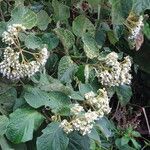A tangled shrub or small tree. It loses its leaves during the year. It is 3-12 m tall. The trunk is crooked. It has many branches and these often droop over. The bark is grey and smooth when young. It later becomes dark and roughly grooved. The leaves are grey-green. They are narrow and oblong. They can be 9 cm long. They feel rough to touch and have hairs on both sides. The tip of the leaf is rounded. The leaf stalk is 1 cm long. Leaves are almost opposite. The flowers are small and like tubes. The 4 or 5 petals are bent backwards. They are fused into a short tube at the base. The flowers are creamy white. They have a sweet smell. The flowers occur in clusters at the ends of branches. They grow on branched hairy stalks. The fruit is oval and 2 cm long. It has a tip at the end and is held in a cup of leaves (calyx). The fruit is orange-red and has a sticky edible pulp. There are 1-4 tiny seeds. The seeds are embedded in a clear pulp.
Leaves opposite, subopposite or alternate; petiole 0.3–1.0(1.5) cm. long usually with some long pale hairs; lamina 3–9 x 1.0–4.5 cm., narrowly obovate to elliptic, rarely oblanceolate, with minute bulbous-based appressed or slightly ascending hairs and sometimes with scattered white bristles to subglabrous but often dotted with groups of cystoliths above, with minute bulbous-based hairs appressed in all directions or pubescent to subglabrous but usually with dense long hairs on the axils of the secondary nerves and along the midrib (sometimes not much evident) below, obtuse to rounded and sometimes retuse at apex, acute to obtuse and often slightly asymmetrical at base, margins entire to crenate or serrate to the upper half, papery to leathery, greyish-green or yellowish-green, with 5–7 secondary nerves on each side of the midrib.
Small tree or shrub, 4-8 m high. Leaves opposite to alternate, narrowly obovate to elliptic, above rough and often densely covered with cystoliths, below with short ± appressed hairs in all directions and longer hairs in axils and along midrib. Calyx smooth, pubescent or minutely fulvous-tomentose outside. Flowers white; January to February and in May and August.
Fruit 12–15 x 8–11 mm., ovoid or ellipsoid, apiculate, glabrous, yellow, orange or reddish when ripe, surrounded at the lower third by the widely enlarged, usually cream, campanulate calyx; mesocarp fleshy; pyrene c. 8 x 7 mm., ± rhomboidal or quadrangular in cross section, 1–3 seeded.
A shrub usually up to 4 m. or a bushy tree up to 8 m. high; branchlets angular, fulvous-tomentellous to subglabrous when young, glabrescent, often cream becoming grey or brown and lenticellate with age.
Panicle 1.5–6.0 cm. long, little-branched, terminal or axillary; rhachis and branches minutely fulvous-tomentose with scattered long pale hairs to pubescent, often glabrescent.
Corolla white, glabrous; tube 2.5–4.0 mm. long, cylindrical; lobes 4, 3.0–4.0 x 1.2–2.0 mm., oblong to narrowly obovate, rounded at apex, reflexed.
Ovary c. 2 mm. long, ovoid, glabrous; style 5–7 mm. long, first-forked at 2.0–2.5 mm. and with stigmatic branches 2–3 mm. long, clavate.
Calyx 4–5 mm. long, narrowly campanulate, irregularly 3–5-toothed, pubescent or minutely fulvous-tomentose outside, strigose inside.
Stamens 4, inserted at the corolla-throat; filaments 2–3 mm. long, glabrous; anthers c. 1.5 mm. long, oblong.
Flowers male on pedicels 0.5–1.5 mm. long.
Pending.


